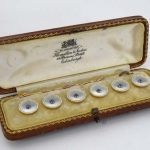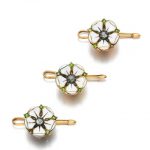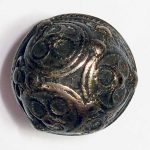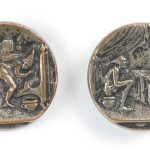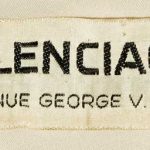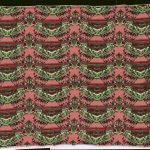Stud buttons (also push-through buttons or just studs) are composed from an actual button, connected to a second, button-like element by a narrow metal or plastic bar. Pushed through two opposing holes within what is meant to be kept together, the actual button and its counterpart press it together, keeping it joined. Popular examples of such buttons are shirt studs and cufflinks. Reference: Wikipedia
A cased set of 6 15ct gold dress studs / buttons with mother of pearl and blue semi precious cabachon to centre. The case marked with retailers details for ‘ Hamilton & Inches 88 Princes Street Edinburgh ‘
Sold for £160 at Dickins Auctioneers Ltd in 2014
A set of three enamel, demantoid garnet and diamond dress buttons, circa 1905 The dress studs each designed as the White Rose of York, decorated with white enamel set with a rose diamond at the centre and accented with circular demantoid garnets between the petals, each approximately 13mm in diameter, two demantoid garnets deficient.
Te White Rose of York, also called the Rose alba or rose argent, is a white heraldic rose and the symbol of the House of York. This has now been established also as the symbol of the county of Yorkshire. The use of the Rose as a political symbol can be traced back to the War of the Roses when the Houses of York and Lancashire adopted the White and Red Rose as their respective emblems. After Henry Tudor united the rival houses of Lancaster and York the title of the Duke of York became a royal prerogative and is traditionally given to the second son of the reigning monarch. George V was given this title prior to becoming Prince of Wales in 1901. It is therefore probable that King George V gave these cufflinks to his son who was born, Prince Edward of York. King George VI was also the Duke of York from 1920, until he ascended the throne in 1936.
Sold for 5,000 GBP at Sotheby’s in 2014
Silver stud button, with a domed face decorated with applied granules, very worn and flattened, and rings of twisted wire.
Silver buttons were an important element of traditional dress throughout Europe in the 19th century. Most had a loop on the back for attachment, but in Norway and Sweden stud buttons were also used. These were mainly worn by men, at the throat, to keep their shirts closed. They were usually decorated with filigree. This stud button probably dates from the 18th century, although it is unmarked. The pattern, of applied circles of twisted wire, dates back to the late Middle Ages, when it was found on spherical buttons all over Europe. By the 19th century they survived only in the north, in Scandinavia and Russia. This button comes from Färs, in Skåne, in the extreme south of Sweden. Skåne province has the richest tradition of jewellery, and more was worn there than in any other district. Almost all the Swedish traditional jewellery at the V&A comes from Skåne.
Reference: © Victoria and Albert Museum
A rare pair of pictorial stamped surgeon’s cloak buttons, most probably German, early 18th century, the first with a scene of a doctor administering an enema to a patient in a bedroom interior, with sleigh bed and chamber pot in view, the second with the patient using chamber pot with the doctor standing over him with the enema under the bed drapes, each in hollow nickel metal with rolled stud construction to verso – each 1.1/8in (2.8cm) diameter
Sold for £ 812 inc. premium at Bonham’s in 2011
[geolocator_show for=”GB”][ebayfeedsforwordpress feed=”http://rest.ebay.com/epn/v1/find/item.rss?keyword=stud+buttons&categoryId1=41192&sortOrder=BestMatch&programid=15&campaignid=5338620288&toolid=10039&customid=pastimefashions-rss-uk-stud-buttons&minPrice=50.0&listingType1=All&feedType=rss&lgeo=1″ items=”20″][/geolocator_show]
[geolocator_hide for=”GB”][ebayfeedsforwordpress feed=”http://rest.ebay.com/epn/v1/find/item.rss?keyword=stud+buttons&categoryId1=156325&sortOrder=BestMatch&programid=1&campaignid=5338620289&toolid=10039&customid=pastimefashions-rss-us-stud-buttons&minPrice=50.0&listingType1=All&feedType=rss&lgeo=1″ items=”20″][/geolocator_hide]
